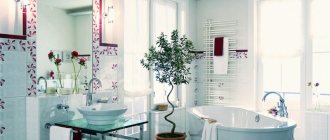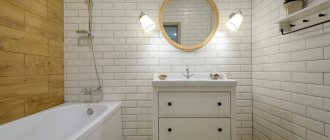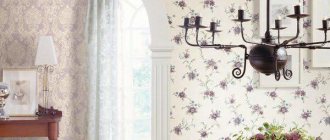At the moment, Provence is a stylistic solution that is most often used when decorating the interior design of a bathroom in a country house. It is this style that combines lightness and picturesqueness, light and space, helping to create a cozy and warm atmosphere. To create a bathroom in this style, it is not enough to place the accents correctly; it is important to think through every detail.
This style is considered simple (rustic), but this does not mean that creating a cozy bathroom will require little money. The thing is that this style combines vintage and luxury, natural building and finishing materials. In order to create a beautiful bathroom designed in Provence style, you need to fulfill several points, namely:
- Carry out interior finishing (floor, walls and ceiling).
- Buy and install plumbing fixtures.
- Choose furniture.
- Select lighting and additional decorative elements.
Provence style in design
The basis of the style is vintage decor and pastel colors: soft blue, beige, lavender, purple, mint green, cream and pearl.
Distinctive features are wood, ceramics, copper, bronze, brass, decorations in floral and plant motifs. In addition to decoration, the interior is complemented with cute trinkets: figurines, pillows and textiles made from natural materials (cotton, linen) with characteristic rustic colors and patterns (polka dots, flowers, plant motifs), artificially aged furniture with forged elements.
The decoration of the room is calm, because bright inserts of flowers and birds will stand out against a muted background.
Selecting tiles for a bathroom in Provence style
Finishing requires special attention - due to high humidity, moisture-resistant materials will be needed. Therefore, for flooring and walls, it is recommended to choose ceramic tiles that have the following characteristics:
- moisture resistance;
- durability;
- resistance to temperature changes;
- wear resistance and resistance to mechanical damage.
When choosing a finishing material, you should first pay attention to these indicators - the higher they are, the longer the tile will last. You need to be careful when choosing a floor covering - the material must withstand high temperatures if you plan to install a “warm floor” system.
Color solutions
Provence gives a feeling of airiness, lightness, and free space, which is why the color of the finish is kept in light colors. This does not mean that the tiles must necessarily be white - background solutions can have shades from cream to golden pearl. Required palette:
- Wood. This is a natural material, and therefore its use to create a Provencal interior is irreplaceable.
- Greenery. Meadow grass, foliage, garden lawn, olive trees refresh and at the same time emphasize the aesthetics of the interior.
- Delicate pastel colors. Warm pink, calm beige, golden sunny, sky blue - all these colors are of natural origin and symbolize flowers, sky, earth, sun.
Ornaments
The main idea of the style is nature, therefore the patterns should carry natural symbolism. This means that flowers, intertwining plants, trees and grass clearly appear against a light background. An obligatory element of this interior is lavender flowers, and Provence is determined by them.
In addition to floral motifs, tile designs can have:
- square inserts;
- repeating jacquard patterns;
- images of birds.
When choosing Provencal tiles, you should also take into account the size of the room itself. For large bathrooms, large tiles with a single large pattern are suitable, but for a small room it is better to choose small tiles, whose pattern will not visually occupy the entire space.
Surface texture
Can be presented in the following forms:
- Matte. The surface of the tile is without shine, porous, rough to the touch.
- Semi-matte. Has a satin surface.
- Glossy. The surface is smooth, shiny, and has good reflective properties.
Despite the variety of color and texture solutions, designers recommend using tiles with a matte or semi-matte surface for the interior. Glossy tiles are slippery, and it is undesirable to use such surfaces in the bathroom to avoid a traumatic situation.
Tile layout
Depending on the pattern, tiles in the bathroom can be laid in various ways:
- "Seam to seam." The simplest layout option is when the tiles are plain, rectangular in shape.
- In a checkerboard pattern. The same “seam to seam” method, only tiles of 2 different shades are used.
- Linear. The layout of the tiles is the same as in the “seam to seam” method, the elements are the same size. The design provides for the use of 2 or more shades.
- Diagonally. The elements are laid diagonally, the rows resemble crossed lines.
- In the dressing. The layout of the tiles is similar to brickwork, when subsequent rows are laid out with a slight offset relative to the previous ones.
- Ornament. Layout with a finished pattern or a solid pattern.
- Modular. This method uses 3 different sizes of tiles, 1 or several shades.
There are other types of layouts:
- horizontal;
- vertical;
- carpet;
- decorative groups (for example, as panels);
- into a cage.
Choosing Provence tiles for the bathroom
To create a magnificent French style, exclusively muted natural colors and natural materials are used. Most often, the role of finishing materials is played by tiles, wood, and brick. There are also some factors that you should pay attention to when choosing.
Color solution
An organically selected color palette has the most favorable effect on the mood of all family members. Provence style ceramic floor tiles have several basic shades.
For decoration, decorators advise using the following colors and shades:
- pearly white;
- beige;
- sky blue;
- light pink;
- jade;
- lavender.
Cool natural shades allow you to create the most comfortable, calming atmosphere.
Ornaments
The founders of the rustic style were French farmers, who primarily cared not about beauty, but about the environmental friendliness of the finishing material, so this style is more suitable for married couples who value coziness, comfort, and harmony. The decoration is completely devoid of flashy colors or showy elements; the furnishings look sophisticated and elegant.
An unusual ornament can become a bright accent of the interior. To do this, it is better to use tiles with a floral print, floral pattern, or amazing pastoral compositions. Quite often, checks, stripes, and panels in a bathroom with a marine theme are used to decorate surfaces. The patterns created should not stand out too much, but only complement the natural aesthetics of the style.
Surface texture
There are several categories of Provence ceramic tiles:
- glossy - its main difference is its shiny surface;
- matte – has a porous, non-shiny surface;
- semi-matte - has a satin surface.
Glossy
Matt
Semi-matte
Designers do not recommend using spectacular glossy shiny surfaces. It is better to give preference to matte coatings that have slight abrasions and roughness. The texture of the finishing material is as close as possible to the texture of natural materials.
After decorating, you should get the feeling that the tiles were made and laid by ancient masters. The greatest similarity can be achieved if the walls are not completely covered, leaving unfilled areas, as if the decoration in this place has undergone changes over the years.
Particular attention should be paid to the type of tile surface:
- smooth - has no protrusions or depressions;
- embossed – has a non-uniform surface of different thicknesses.
For the bathroom, you should choose a textured material that will avoid injury while in the room. The same cannot be said about smooth tiles, which can be very slippery when wet.
Surface design methods
In the bathroom, it is desirable to use moisture-resistant material, so both the walls and the floor are tiled or tiled. Since Provence implies an abundance of decor, the decoration itself should be minimalist in color.
Floor
A matte finish is the best option. Most often, they choose a color similar to natural wood or calm, non-staining shades: beige, light brown, dark chocolate, coffee, “coffee with milk” color. In some cases, a lighter color scheme is used than for the walls - pearl, light gray, light beige.
Walls
Despite the fact that Provence-style tiles most often have a white background, bouquets of flowers and intricate patterns soften the strict purity. Designers recommend choosing plain materials - cream, sand, olive. However, you can play with light wall decoration in contrast with terracotta inserts made of smaller tiles than the main fragments.
As an option, showers are decorated in a “marine” color, laying panels of richer shades than the flooring and the main background. As a contrast with blue tiles, you can use white and brown.
Furniture and plumbing
The furniture should be vintage, antique-style, slightly shabby, shabby. You can use artificial aging of the facade of the cabinet under the sink, brass or bronze-imitation elements (legs, holders, mixer), and a frame for the mirror. An important condition: some carelessness and at the same time grace and roundness of forms, smooth lines.
Plumbing in Provence contains elaborate additional elements: stucco molding on the bathtub, installations, sinks of outdated design. Furniture can have pastel shades, but plumbing fixtures must certainly be snow-white. In rare cases, bath bowls are dark and have elaborate legs. A prerequisite is grace and roundness of shapes, smooth lines.
Lighting
Since the interior in the Provence style implies light shades, the lighting should be subdued so that the finish does not bother the eye with its strict snow-whiteness. Both chandeliers for the main light and local lighting in the form of wall sconces are suitable here.
But the main source of light is a large window in a white frame with light curtains with patterns that echo the colors of the overall design.
Manufacturers of the Provence style tile collection
There are many factories producing Provence style tiles, but the leading ones are:
- Kerama-Marazzi (Russia-Italy). Fruits, fish and olives are the main theme of Provencal cuisine, which is carried over to the tiles. The company produces fragments of a standard size of 200x400 mm.
- Peronda Provence (Spain). The tiles have a glossy surface, pastel colors and floral arrangements in the Provence style.
- "Berasekeramika" (Belarus). Tiles with a glazed surface in large sizes. The main advantages are high strength and clear images of the most complex designs applied using digital printing.
- "Uralkeramika" (Russia). The “Provence” collection is represented by tiles with imitation marble and an abundance of decor. The presence of such elements allows you to create entire pictures on the walls: false windows, lamps, niches with flower vases.
Furniture and plumbing
Bathroom furniture in the Provence style, like plumbing fixtures, should have a vintage look. Therefore, it is necessary to choose models of traditional shape, with a classic design and made from natural materials. You can use antique furniture or artificially aged modern furniture. Designers adhere to certain rules when decorating a bathroom in Provencal style:
- Bathroom furniture, referring us to the Provencal style, should be elegant and light. Carved models and models with ornaments fit well into the interior. A good solution is to use assorted furniture from different sets; this conveys an atmosphere of light, slightly careless French chic. In spirit, the Provencal style is close to wicker furniture, made from untreated wood or painted in pastel colors.
- Plumbing for a Provencal interior should be classic and elegant. It is important to choose models with smooth lines, oval shapes, bathtubs with graceful legs made of heavy cast iron, artificial or natural stone. Old-fashioned valves will complete the retro look of the interior.
Note! Inside a bathroom with a Provençal design there is usually quite a lot of furniture. However, bathroom furniture in the Provence style should be light and compact so that there is plenty of space in the room.
Bathroom in Provence style: interior ideas
The stylization of the French province is contained in the improvement of the interior, where the light colors of the decoration contrast with the bright colors of the furniture and accessories. Mandatory attributes are abrasions on furniture, mirror frames, as well as handles, faucets and towel holders made of metal coated to imitate aged gold or bronze.
Provence should bring lightness and peace to the interior, so it requires an abundance of light surfaces. You can dilute pastel colors with bright inserts of decoration and interior items. The originality of Provence does not accept the modernity of shiny surfaces, so gloss is inappropriate here.
However, the facelessness of snow-white surfaces is also not welcome. You can pick up fragments on the walls that are assembled into a single picture. In long narrow bathrooms, white tiles with small bright flowers will be a good technique for visually expanding the room.
The flooring should be chosen slightly darker than the tone of the furniture. A prerequisite is natural colors: wood, vegetation, stone. The beige color with small square inserts looks good.
Also, the interior should contain forged elements (for example, a bathtub with vintage legs). Furniture (chest of drawers, cabinet under the sink, cabinets for linen and washing supplies) is selected in a single color scheme. Pots of flowers placed on the shelves will help refresh the interior.
Small bathroom design
To create a bathroom in the Provence style in a typical city apartment, you will have to sacrifice separate amenities and combine the bathroom and toilet to obtain the necessary space.
Light and romantic design visually increases the space.
The main thing is not to overload the room with unnecessary details:
- It is better to choose narrow, compact plumbing fixtures: in a small room, beautiful stands or curly legs will not be visible, but this will add space.
- The overall color scheme of the bathroom should be kept monotonous, without large prints, in the lightest, most pastel colors.
- Missing windows can be replaced with a large mirror, which will double the lighting and visually enlarge the room.
- It is better to refuse accessories that do not carry a functional load: candles, frames, figurines.
It is worth paying special attention to such details as the aged facade of the cabinet under the sink, a stylized entrance door, a beautiful metal or earthenware frame for a mirror, lamps in the form of candelabra, and a wicker laundry basket.
If you do not violate the basic principles of style and pay attention to the advice of designers, then even a standard city bathroom can become a part of a wonderful place called Provence.











